Controlling The Flinch, The Blink and The Turn Away
By Christopher Caile
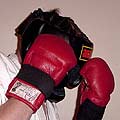 You
see it in a lot of students who are just beginning to freefight in karate,
taekwondo and kung fu. They are scared and aren't sure what they are doing. You
see it in a lot of students who are just beginning to freefight in karate,
taekwondo and kung fu. They are scared and aren't sure what they are doing.
When a punch or kick comes at them, they react -- they flinch, cover
their head, blink their eyes, and sometimes even turn their back. You
can almost hear the internal dialogue, "On no. Here it comes. I'm
going to get hurt."
Freefighting is at first very uncomfortable. This type of reaction is
natural -- an instinctive response in an effort to defend yourself.
The result, however, is that the student is put at a momentary disadvantage
since this type of reaction creates an opening an opponent can exploit.
In competition the student might lose a point, but on the street this
type of reaction can put him or her in real jeopardy.
If you blink you lose sight of an opponent momentarily. Vision is also
disorientated during a flinch as everything becomes a blur of movement.
And if you turn away, everything is exposed.
So what can you do? Actually there is a lot you can do, and answers fall
into several general categories. You can retrain your reflexes, re-orient
your attitude and learn how boost your visual
skills.
Retraining The Reflexive Body
First you should gradually learn how to confront and deal with attacks
- something that will reduce your fear and teach you how to control the
natural instincts to run, flinch, blink or turn away.
One way to do this is through various drills. They go a long way
to allow you to eliminate your fear in a safe environment.
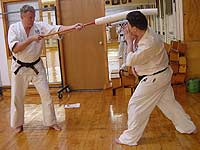 One
of the best drills is to use a pad (often on a handle) to simulate various
attacks -- straight punches and hooks to the head, body shots and various
types of kicks. Try to keep a proper fighting position, hands up, and
move -- shift position, duck under hooks, and shift your head to the side
of a punch (known as slipping a punch) while blocking it with your hand
or forearm. Gradually you will become more comfortable with being attacked
and the pace can be increased. One
of the best drills is to use a pad (often on a handle) to simulate various
attacks -- straight punches and hooks to the head, body shots and various
types of kicks. Try to keep a proper fighting position, hands up, and
move -- shift position, duck under hooks, and shift your head to the side
of a punch (known as slipping a punch) while blocking it with your hand
or forearm. Gradually you will become more comfortable with being attacked
and the pace can be increased. 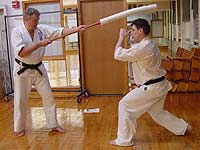 The
pace of the practice attack should always push you a little beyond where
you feel comfortable. This forces you to improve. The
pace of the practice attack should always push you a little beyond where
you feel comfortable. This forces you to improve.
Later, actual punches and kicks can be introduced -- at first done slowly
and over time increased in speed and power. While you may just be defensive
at first, after a while you will learn to also take the offensive. Be
careful to use protective equipment unless you are practicing this drill
in slow motion.
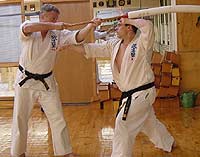 On
an advanced level a similar activity entails actually allowing soft punches
to land. If you are more advanced you can allow harder punches. Through
this method you will learn how to take a punch, how to tighten up or move
to eliminate its effects and this will reduce the fear factor by reducing
perception of possible pain. Avoid any actual hits to the head, however.
This is dangerous. On
an advanced level a similar activity entails actually allowing soft punches
to land. If you are more advanced you can allow harder punches. Through
this method you will learn how to take a punch, how to tighten up or move
to eliminate its effects and this will reduce the fear factor by reducing
perception of possible pain. Avoid any actual hits to the head, however.
This is dangerous.
The Mental Switch To Offense
Most beginners focus on defense and not getting hurt. Mentally they are
defensive and physically they are hesitant. They are waiting to get hit
or hurt, and when anything comes near them they jump in anticipation.
Try to reorientate your thinking to one of offense, not defense. Mental
focus will change from avoidance of getting hit to a focus on attack.
You will begin to look for an opening and your dialogue will change too:
"Good, here comes an attack I can respond to." Fear is reduced
because attention has shifted elsewhere.
Visual Reorientation
Another method to reduce flinching, blinking and turning away is to be
able to re-educate how you use and control your eyes.
To reduce blinking you can control the muscles of the eyelid.

Many mistakenly try to hold their eyelids open to stop blinking, but
this doesn't work because blinking is done with the muscles that close
the lids, not open them.

Thus to stop or reduce the tendency to blink, slightly narrow your eyes,
thus bringing conscious control over the muscles used in blinking. Have
a partner punch to either side of your head, or jab toward you face but
at a distance that contact won't be made. Practice controlling your blink
reaction. Keep your eyes narrowed, observing everything, but not focusing
on anything.
One way to help control flinching is to minimize the surprise of an opponent's
actions. Visually this can be done in two ways. At the start of freefighting,
or when action has momentarily ceased, I teach my students to look into
their opponents' eyes but also perceive their whole body -- at least at
the beginning.
The eyes will indicate when your opponent is about to attack. So practice
picking up signals from your opponents' eyes. They provide great forewarning.
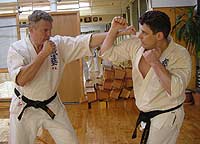 When
there is action during freefighting you can also use your vision to reduce
the potential surprise of an opponent's second or third technique. Do
not focus on the attack itself, for if you look at it, it will fill your
visual field and block your perception of what's following. Instead you
should look past any attack for what is coming next. This gives you more
time to react since you will pick up attacks as they are launched, not
as they are about to land. This give you time to react. When
there is action during freefighting you can also use your vision to reduce
the potential surprise of an opponent's second or third technique. Do
not focus on the attack itself, for if you look at it, it will fill your
visual field and block your perception of what's following. Instead you
should look past any attack for what is coming next. This gives you more
time to react since you will pick up attacks as they are launched, not
as they are about to land. This give you time to react.
About The Author:
Christopher Caile is the Founder and Editor-In-Chief of FightingArts.com.
He has been a student of the martial arts for over 40 years and holds
a 6th degree black belt in Seido Karate and has experience in judo,
aikido, diato-ryu, boxing and several Chinese fighting arts. He is also
a long-term student of one branch of Traditional Chinese Medicine, Qigong.
He is a personal disciple of the qi gong master and teacher of acupuncture
Dr. Zaiwan Shen (M.D., Ph.D.) and is Vice-President of the DS International
Chi Medicine Association. In Buffalo, NY, he founded the Qi gong Healing
Institute and The Qi Medicine Association at the State University of
New York at Buffalo. He has also written on Qi gong and other health
topics in a national magazine, the Holistic Health Journal and had been
filmed for a prospective PBS presentation on Alternative Medicine. Recently
he contributed a chapter on the subject to an award winning book on
alternative medicine, "Resources Guide To Alternative Health"
produced by Health Inform.
|